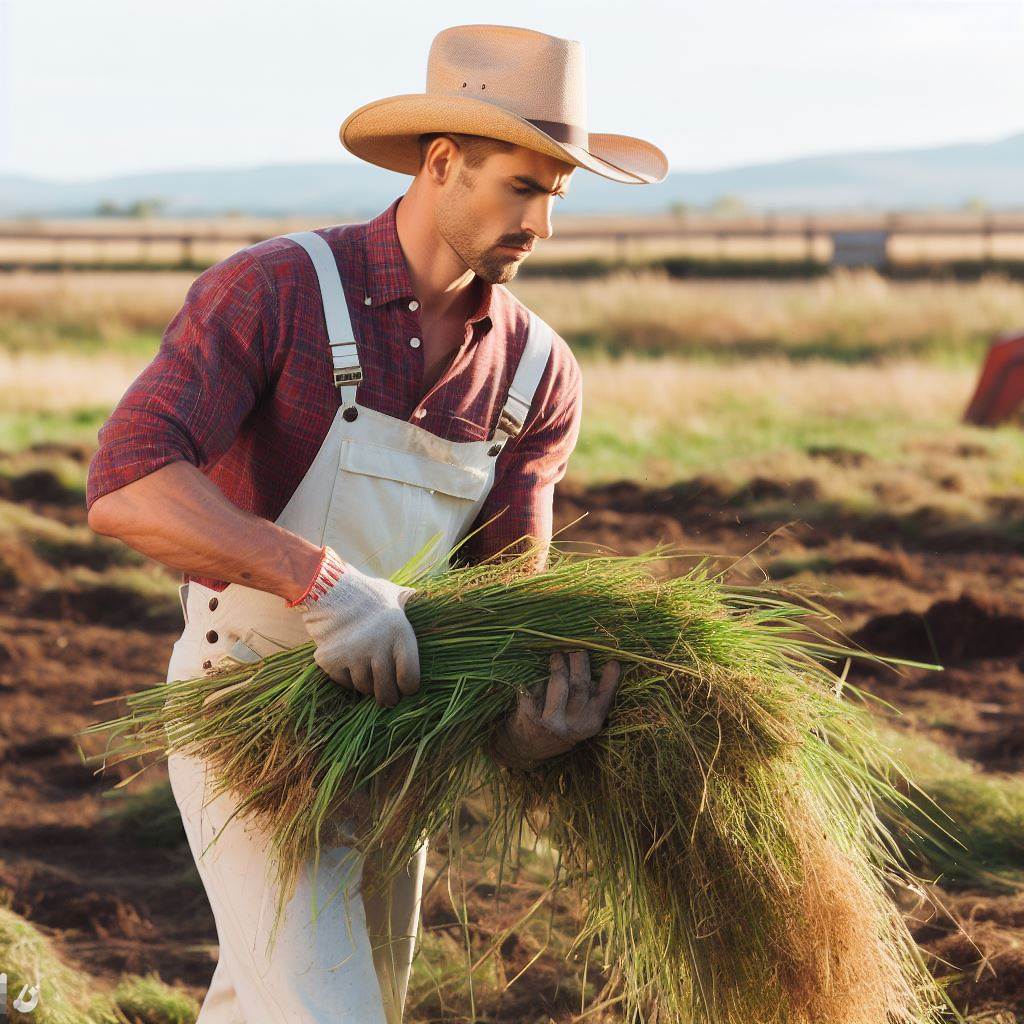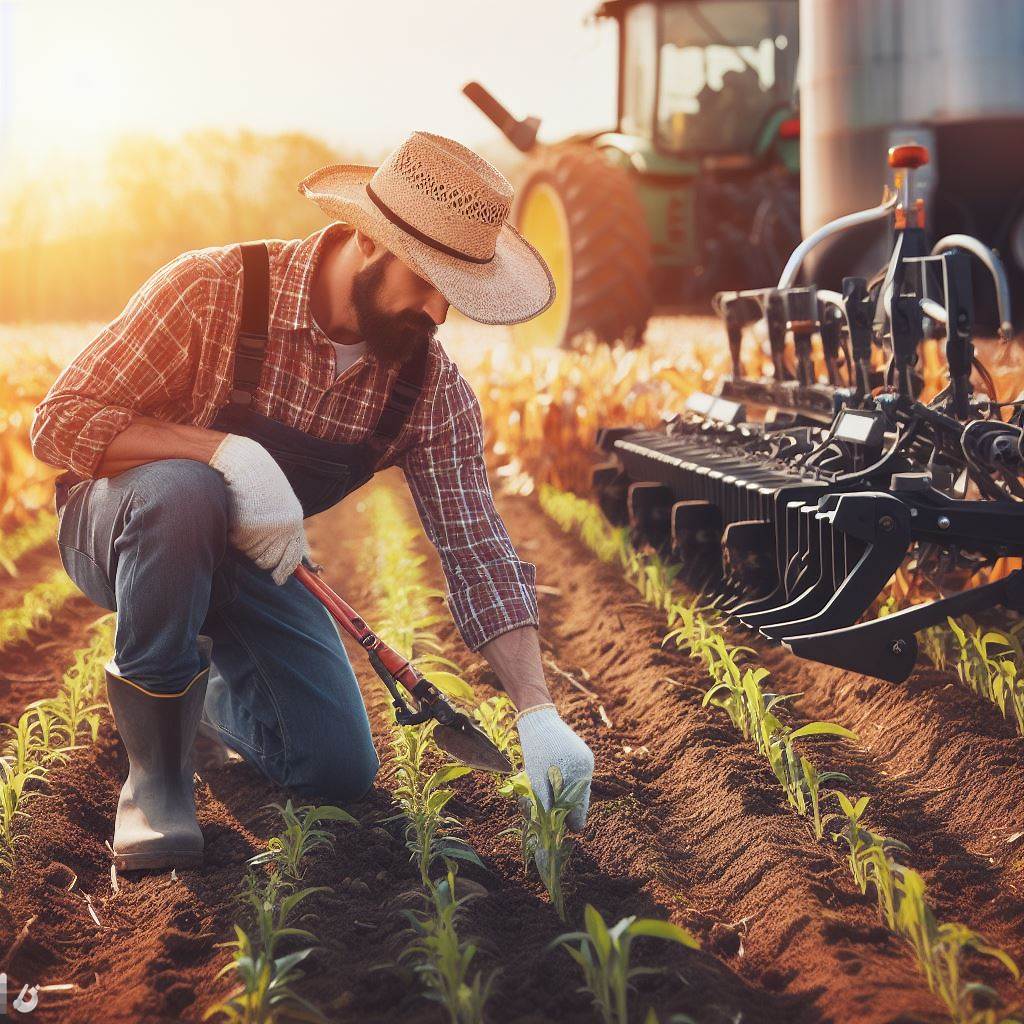Introduction
A. The importance of weed control in crop cultivation
Weed control plays a crucial role in crop cultivation, ensuring the success and productivity of the crops.
Without effective weed control, weeds can compete with crops for nutrients, water, and sunlight, leading to reduced crop yield and quality.
B. The negative impacts of weeds on crop yield and quality
Weeds have negative impacts on crop yield and quality.
They can cause significant yield losses by utilizing resources that are meant for the crops.
Weeds also compete with crops for sunlight, which can hinder their growth and development.
Moreover, weeds harbor pests and diseases, acting as hosts and vectors, further impacting the health and productivity of the crops.
This can result in reduced crop quality, making them susceptible to various diseases and infestations.
Additionally, weeds can decrease the overall value of the crop by contaminating the harvested product.
Presence of weed seeds or parts in the final product not only affects the appearance but also reduces market value and consumer acceptance.
Furthermore, weeds can affect the efficiency of farming operations.
They interfere with the use of machinery and equipment, leading to increased labor costs and potential damage to the crops during harvesting.
In fact, weed control is essential in crop cultivation to maintain high crop yield and quality.
By preventing competition for resources, reducing the spread of pests and diseases, and ensuring efficient farming operations, weed control significantly contributes to the success of crop cultivation.
Understanding Weeds
A. Definition and Characteristics of Weeds
Weeds are unwanted plants that grow alongside cultivated crops, usually in large numbers.
These plants may have specific characteristics such as rapid growth, ample seed production, and adaptability to diverse environments.
Transform Your Agribusiness
Unlock your farm's potential with expert advice tailored to your needs. Get actionable steps that drive real results.
Get StartedB. Competition for Resources and Effects on Crop Growth
Weeds compete with crop plants for essential resources like sunlight, water, nutrients, and space.
This competition can hinder the growth and development of crops as weeds consume resources that are vital for crop productivity.
Weeds can also attract pests and diseases, further impacting the health of crops.
C. Types of Weeds Commonly Found in Crop Cultivation
To effectively control weeds, it is crucial to identify and understand the different types commonly found in crop cultivation:
1. Grass Weeds
These are monocotyledonous weeds that resemble grasses, such as barnyardgrass, foxtail, and crabgrass.
They can quickly spread and outcompete crops for resources.
2. Broadleaf Weeds
These dicotyledonous weeds have broad leaves and include species like pigweed, dandelion, and lambsquarters.
Broadleaf weeds can rapidly colonize fields and adversely affect crop growth by shading cultivated plants.
3. Sedge Weeds
Sedges, like yellow nutsedge and purple nutsedge, are perennial grass-like weeds that thrive in moist environments.
They are particularly challenging to control due to their aggressive nature and ability to spread through rhizomes.
4. Perennial Weeds
Perennial weeds, such as bindweed and Canada thistle, persist for multiple years, regrowing from their root systems.
These weeds can be highly competitive and difficult to eradicate without proper management strategies.
5. Aquatic Weeds
As the name suggests, these weeds grow in aquatic or semi-aquatic environments, including water hyacinth, duckweed, and water milfoil.
They can hinder irrigation, block sunlight penetration, and disrupt the ecosystem balance of water bodies.
6. Parasitic Weeds
Parasitic weeds, like witchweed and dodder, depend on other plants for their nutrition.
They attach themselves to host plants and extract resources, weakening the growth and overall health of the host crop.
D. Importance of Effective Weed Control in Crop Cultivation
Implementing efficient weed control practices is essential for successful crop cultivation due to the following reasons:
- Enhanced Resource Utilization: By minimizing weed competition, crops can efficiently utilize available sunlight, water, and nutrients for optimal growth.
- Protection against Yield Losses: Weeds can significantly reduce crop yields by stealing essential resources, and their timely control helps prevent economic losses.
- Prevention of Disease and Pest Infestation: Weeds can serve as hosts for pests and diseases, managing them helps in mitigating potential pest and disease outbreaks in crops.
- Improved Aesthetic Appeal: Weed-free fields are visually appealing and facilitate easy crop management and harvesting.
- Sustainable Agriculture: Effective weed control reduces the need for excessive herbicide use and promotes sustainable agricultural practices, minimizing environmental impact.
Weeds pose a significant challenge to crop cultivation by competing for resources necessary for crop growth and productivity.
Recognizing the types of weeds commonly found in crop fields and understanding their characteristics is crucial for the development of effective weed control strategies.
By implementing proper weed management techniques, farmers can maximize crop yields, reduce economic losses, and contribute to sustainable agriculture.
Read: Soil pH and Its Impact on Crop Growth
Common Weed Control Methods
Weed control is a crucial aspect of successful crop cultivation.
To ensure optimal yields and prevent weed competition, farmers employ various control methods.
This blog section will discuss the three most common weed control methods: mechanical, chemical, and cultural.
Showcase Your Farming Business
Publish your professional farming services profile on our blog for a one-time fee of $200 and reach a dedicated audience of farmers and agribusiness owners.
Publish Your ProfileA. Mechanical control methods
Mechanical control methods involve the use of physical tools to physically remove weeds from crop fields.
Machinery such as tillers and cultivators can effectively uproot and separate weeds from desired crops.
The advantages of mechanical control methods include their cost-effectiveness and minimal environmental impact.
By avoiding chemical inputs, farmers can reduce their reliance on synthetic substances.
However, mechanical methods have limitations too.
They can cause soil erosion if used improperly and often require labor-intensive work.
B. Chemical control methods
Chemical control methods, on the other hand, involve the use of herbicides to suppress or eliminate weeds.
Herbicides are chemical substances specifically designed to target and kill unwanted plant species.
They can be selective, targeting specific types of weeds, or non-selective, affecting all vegetation.
Selective herbicides are useful when dealing with diverse weed populations, while non-selective herbicides are suitable for complete vegetation control.
Proper herbicide selection and application are vital to achieve effective weed control while avoiding harm to desired crops and the environment.
C. Cultural control methods
Cultural control methods focus on altering the agricultural practices and environment to prevent weed growth and spread.
Crop rotation and cover crops are commonly employed to disrupt the weed’s life cycle and reduce their population.
By rotating crops, different weed species are forced to compete with unfamiliar crops, reducing their dominance.
Cover crops can act as smothering agents, crowding out weeds and depriving them of sunlight and nutrients.
Additionally, proper soil preparation and fertility management practices promote healthy crop growth while suppressing weed development.
Techniques such as mulching and creating weed-free seedbeds also serve as cultural control methods that hinder weed proliferation.
In general, effective weed control in crop cultivation necessitates the implementation of various control methods.
Mechanical methods provide a cost-effective and environmentally friendly approach but require careful management to prevent soil erosion.
Chemical methods, when used correctly, can effectively eliminate weeds, but proper selection and application are crucial to minimize negative impacts.
Cultural methods, including crop rotation, cover crops, and soil management practices, offer long-term weed management solutions.
By combining these different control methods, farmers can achieve successful weed control and ensure productive crop yields.
Read: Cotton Cultivation: Best Practices and Tips

Gain More Insights: Futuristic Farm Tools: Tomorrow’s Agriculture
Integrated Weed Management
Integrated Weed Management (IWM) is a comprehensive and sustainable approach to controlling weeds in crop cultivation.
It involves the combination of different strategies to effectively manage weed populations and minimize crop damage.
By integrating various methods, IWM ensures long-term weed control and reduces the dependence on a single control measure.
A. Benefits of Implementing an Integrated Approach
Implementing an integrated approach to weed control offers several benefits for crop cultivation.
Firstly, it helps in minimizing the development of herbicide resistance in weed populations.
By using a combination of mechanical, chemical, and cultural methods, the reliance on herbicides alone is reduced, making it harder for weeds to adapt and develop resistance.
Moreover, IWM promotes sustainable farming practices by minimizing the environmental impact associated with excessive herbicide use.
By using non-chemical methods like mechanical control and cultural practices such as crop rotation and cover cropping, farmers can reduce the amount of herbicides sprayed and thus prevent contamination of water sources and ecosystems.
Another advantage of IWM is its ability to target multiple weed species simultaneously. Different weeds have different life cycles, growth habits, and resistance mechanisms.
By combining various control tactics, IWM can effectively target and suppress a wide range of weed species, enhancing overall weed control efficacy.
B. Examples of IWM Strategies
IWM involves the integration of mechanical, chemical, and cultural methods to achieve effective weed control.
One common IWM strategy is the use of tillage practices, such as plowing and cultivating, to physically remove weeds from the soil.
This method is particularly effective for annual weeds with shallow roots.
Chemical control methods, such as the use of herbicides, can also be integrated into the IWM approach.
By selectively applying herbicides to target specific weed species, farmers can minimize the overall herbicide use while maximizing weed control efficacy.
However, it is crucial to follow label instructions and avoid excessive use to prevent environmental contamination.
Showcase Your Farming Business
Publish your professional farming services profile on our blog for a one-time fee of $200 and reach a dedicated audience of farmers and agribusiness owners.
Publish Your ProfileCultural practices play a significant role in IWM as well.
Crop rotation, for example, can break the life cycle of weeds by alternating susceptible and non-susceptible crops.
This reduces the buildup of specific weed species and helps maintain a more balanced weed population.
Additionally, using cover crops can help smother weeds, compete for resources, and enhance soil health, contributing to effective weed management.
C. The Importance of Monitoring and Regular Assessment
Monitoring and regular assessment are essential components of IWM.
By regularly inspecting fields and assessing weed populations, farmers can identify potential problem areas and take timely action to prevent further weed infestation.
Regular assessment also helps in identifying the effectiveness of different control measures and making necessary adjustments for optimal weed management.
Through monitoring, farmers can track changes in weed species composition, emergence patterns, and herbicide resistance.
This allows for the appropriate selection and modification of control strategies based on the specific weed species present in the field.
Timely detection and intervention help to prevent weed seed production and minimize the long-term impact of weeds on crop yields.
In a nutshell, integrated weed management offers a holistic approach to weed control in crop cultivation.
By combining mechanical, chemical, and cultural methods, farmers can achieve sustainable weed control, reduce herbicide resistance, and minimize environmental impacts.
Monitoring and regular assessment ensure the effectiveness of control measures and facilitate timely intervention.
Implementing an integrated approach will undoubtedly contribute to successful crop production while preserving the long-term health of agricultural ecosystems.
Read: Integrated Pest Management for Fruit Trees
New Developments in Weed Control
In recent years, the field of weed control technology has witnessed significant advancements.
These advancements have revolutionized the way we tackle weed problems in crop cultivation, leading to more effective and sustainable practices.
A. Advancements in Weed Control Technology
Varieties of herbicides with increased potency and selectivity have been developed, ensuring better control of weeds.
Herbicide-resistant crops have been genetically engineered, allowing farmers to use specific herbicides without harming their crops.
New formulations and delivery systems have been introduced, enabling better herbicide targeting and reducing environmental impact.
Weed sensing technologies, such as remote sensing and machine vision, have emerged, helping farmers identify and treat weed-infested areas more efficiently.
Drone technology has also been integrated into weed control, enabling aerial application of herbicides and monitoring of weed populations with high precision.
B. Potential of Precision Agriculture and Automated Weed Control Systems
Precision agriculture has the potential to revolutionize weed control by providing real-time data and optimizing treatments based on specific weed populations and crop requirements.
Through the use of sensors and GPS technology, farmers can precisely target herbicide applications, minimizing wastage and reducing environmental impact.
Automated weed control systems, such as robotic weeders and autonomous machinery, can be programmed to identify and remove weeds without human intervention.
These systems utilize advanced computer vision and machine learning algorithms to distinguish between crops and weeds, ensuring accurate weed control.
Furthermore, these automated systems can work round the clock, covering large areas in a shorter time and achieving more efficient weed control.
C. Alternative and Organic Weed Control Methods
Besides chemical-based approaches, alternative and organic weed control methods have gained attention due to their environmentally friendly nature.
Bioherbicides are naturally occurring substances or biological agents that can effectively suppress or kill weeds.
They often consist of herbicide-producing bacteria, fungi, or plant extracts that specifically target weeds while leaving crops unharmed.
Biocontrols, on the other hand, involve the use of natural enemies of weeds, such as insects or other organisms, to control weed populations.
These methods offer sustainable weed management solutions with minimal chemical use and reduced ecological impact.
In summary, new developments in weed control have transformed the way we approach weed management in crop cultivation.
Advancements in technology, including herbicides, precision agriculture, and automated systems, have made weed control more efficient and eco-friendly.
Additionally, alternative methods like bioherbicides and biocontrols provide sustainable weed control options.
As we continue to explore and develop innovative strategies, we can expect even more effective and environmentally conscious weed control practices in the future.
Read: Hydroponics: Future of Urban Crop Production
Conclusion
Effective weed control is crucial for maximizing crop yield and quality.
We have discussed various key points in this blog post, highlighting the significance of implementing appropriate weed control measures.
By controlling weeds, farmers can prevent competition for nutrients, sunlight, and water, which have a direct impact on crop production.
Showcase Your Farming Business
Publish your professional farming services profile on our blog for a one-time fee of $200 and reach a dedicated audience of farmers and agribusiness owners.
Publish Your ProfileWeed control methods such as manual removal, mulching, and herbicide application should be employed based on the specific needs of the crop and the severity of weed infestation.
It is essential for farmers to stay informed about the latest weed control techniques and technologies to ensure efficient management.
Implementing effective weed control measures not only increases crop yield but also improves the overall quality of the harvest.
By reducing weed competition, crops can grow healthier, stronger, and more resistant to diseases and pests.
This leads to higher market value and profitability for farmers.
I encourage all readers to prioritize weed control in their own crop cultivation practices.
By investing time and effort in weed management, farmers can improve their chances of a successful harvest and achieve better financial outcomes.
Seek advice from agricultural experts, attend workshops, and adopt best practices to tackle weed problems effectively.
Remember, weed control is a continuous process and requires regular monitoring.
Dedicate time to identify and address weed issues promptly.
By taking proactive steps, we can ensure healthier crops, a more sustainable agricultural system, and a secure food supply for generations to come.




